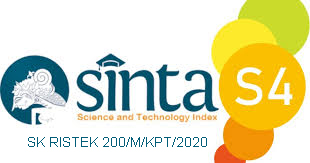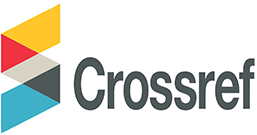Forecasting Blood Demand Using the Support Vektor Regression Method (Case Study: Blood Transfusion Unit-PMI Central Lombok)
Abstract
Keywords
Full Text:
PDFReferences
Y. Heryanita et al., “4. The Value of Erythrocytes, Hemoglobin, and Hematocrit of Mice (Mus musculus) Exposed to Cigarette Smoke and Given Red Watermelon Extract (Citrullus vulgaris),” J. Med. Vet., vol. 12, no. 1, pp. 24–31, 2018, doi: 10.21157/j.med.vet..v12i1.4106.
G. C. Heriyanto, U. K. Petra, J. Siwalankerto, S. Jl, S. Surabaya, and J. Siwalankerto, “Prediksi Kebutuhan Darah Menggunakan Metode ARIMA Dengan Mempertimbangkan Faktor Deterioration,” J. Infra, 2022, [Online]. Available: https://publication.petra.ac.id/index.php/teknik-informatika/article/view/12734%0Ahttps://publication.petra.ac.id/index.php/teknik-informatika/article/viewFile/12734/11036.
H. H. Rohan, Y. Amalia, P. Ayu, and D. Reswari, “Journal of Community Engagement in Health Kegiatan Donor Darah Di Fakultas Ilmu Kesehatan Universitas Dr. Soetomo Surabaya Tahun 2018,” vol. 4, no. 2, pp. 475–480, 2021, [Online]. Available: http://jceh.orghttps//doi.org/10.30994/jceh.v4i2.272.
A. C. Cagliano, S. Grimaldi, C. Rafele, and C. Campanale, “An enhanced framework for blood supply chain risk management,” Sustain. Futur., vol. 4, no. July, p. 100091, 2022, doi: 10.1016/j.sftr.2022.100091.
B. Apriliasari, N. S. Utami, L. Lidia, and A. Abdullah, “AKSI UNIASIAH (Blood Transfusion Unit) Based on Android With Waterfall,” J. Transform., vol. 17, no. 1, p. 57, 2019, doi: 10.26623/transformatika.v17i1.1410.
Kemenkes RI, PROFIL KESEHATAN INDONESIA 2018. 2018.
K. W. D. Nugraha, Profil Kesehatan Indonesia 2021. 2022.
A. Datumaya, W. Sumari, A. K. Febrianto, and Y. Pramitarini, “Sistem Prediksi Permintaan Darah Menggunakan Metode Regresi Linier ( Studi Kasus Pada UTD PMI Kabupaten Bojonegoro ),” J. Inform. Polinema, pp. 85–90, 2021, doi: 10.33795/jip.v7i2.495.
A. Budipriyanto and F. Anggraini, “Manajemen Persediaan Darah Untuk Meminimalkan Shortage dan Wastage pada Bank Darah PMI Jakarta,” Pros. Senantias, vol. 1, no. 1, pp. 1235–1244, 2020.
O. S. S. Filho, W. Cezarino, and G. R. Salviano, A Decision-making Tool for Demand Forecasting of Blood Components, vol. 45, no. 6. IFAC, 2023.
C. Rutherford, S. Y. Cheng, and K. Bailie, “Evidence of bullwhip in the blood supply chain,” 23rd EurOMA Conf. Proc., no. June, pp. 1–10, 2016.
M. Meneses, D. Santos, and A. Barbosa-póvoa, “Modelling the Blood Supply Chain,” Eur. J. Oper. Res., vol. 307, no. 2, pp. 499–518, 2023, doi: 10.1016/j.ejor.2022.06.005.
N. Prastyanda, P. Pratama, T. Sukmono, B. I. Putra, and W. Sulistiyowati, “Forecasting the Amount of Blood Storage Using the Support Vector Machine ( Svm ) Method Peramalan Jumlah Permintaan Darah Menggunakan Metode Support Vector Machine ( Svm ),” vol. 3, no. 07, 2022.
A. D. Dubey, “Gold price prediction using support vector regression and ANFIS models,” Int. Conf. Comput. Commun. Informatics, ICCCI, no. January 2018, 2018, doi: 10.1109/ICCCI.2016.7479929.
R. Melati, T. W. Purboyo, and M. Kallista, “Prediksi Penderita Tuberkulosis Menggunakan Algoritma Support Vector Regression ( SVR ) Prediction Of Tuberculosis Patients Using The Support Vector Regression ( SVR ),” vol. 10, no. 1, pp. 736–741, 2023.
M. R. Rifqi, B. D. Setiawan, and F. A. Bacthiar, “Support Vector Regression Untuk Peramalan Permintaan Darah : Studi Kasus Unit Transfusi Darah Cabang – PMI Kota Malang,” vol. 2, no. 10, pp. 3332–3342, 2018.
A. D. A. Rifandi, B. D. Setiawan, and Tibyani, “Optimasi Interval Fuzzy Time Series Menggunakan Particle Swarm Optimization pada Peramalan Permintaan Darah : Studi Kasus Unit Transfusi Darah Cabang - PMI Kota Malang,” J. Pengemb. Teknol. Inf. dan Ilmu Komput. Univ. Brawijaya, vol. 2, no. 7, pp. 2770–2779, 2018, [Online]. Available: http://j-ptiik.ub.ac.id.
N. A. Siregar, “Peramalan Curah Hujan Di Kota Medan menggunakan Metode Support Vector Regression,” vol. 1, no. 1, pp. 7–9, 2022.
E. Virantika, K. Kusnawi, and J. Ipmawati, “Evaluasi Hasil Pengujian Tingkat Clusterisasi Penerapan Metode K-Means Dalam Menentukan Tingkat Penyebaran Covid-19 di Indonesia,” J. Media Inform. Budidarma, vol. 6, no. 3, p. 1657, 2022, doi: 10.30865/mib.v6i3.4325.
DOI: https://doi.org/10.31326/jisa.v6i2.1780
Refbacks
- There are currently no refbacks.
Copyright (c) 2023 Yati Apriati, Wafiah Murniati, Saikin Saikin, Sofiansyah Fadli, Hairul Fahmi

This work is licensed under a Creative Commons Attribution-ShareAlike 4.0 International License.
JOURNAL IDENTITY
Journal Name: JISA (Jurnal Informatika dan Sains)
e-ISSN: 2614-8404, p-ISSN: 2776-3234
Publisher: Program Studi Teknik Informatika Universitas Trilogi
Publication Schedule: June and December
Language: English
APC: The Journal Charges Fees for Publishing
Indexing: EBSCO , DOAJ, Google Scholar, Arsip Relawan Jurnal Indonesia, Directory of Research Journals Indexing, Index Copernicus International, PKP Index, Science and Technology Index (SINTA, S4) , Garuda Index
OAI address: http://trilogi.ac.id/journal/ks/index.php/JISA/oai
Contact: jisa@trilogi.ac.id
Sponsored by: DOI – Digital Object Identifier Crossref, Universitas Trilogi
In Collaboration With: Indonesian Artificial Intelligent Ecosystem(IAIE), Relawan Jurnal Indonesia, Jurnal Teknologi dan Sistem Komputer (JTSiskom)
JISA (Jurnal Informatika dan Sains) is Published by Program Studi Teknik Informatika, Universitas Trilogi under Creative Commons Attribution-ShareAlike 4.0 International License.


















